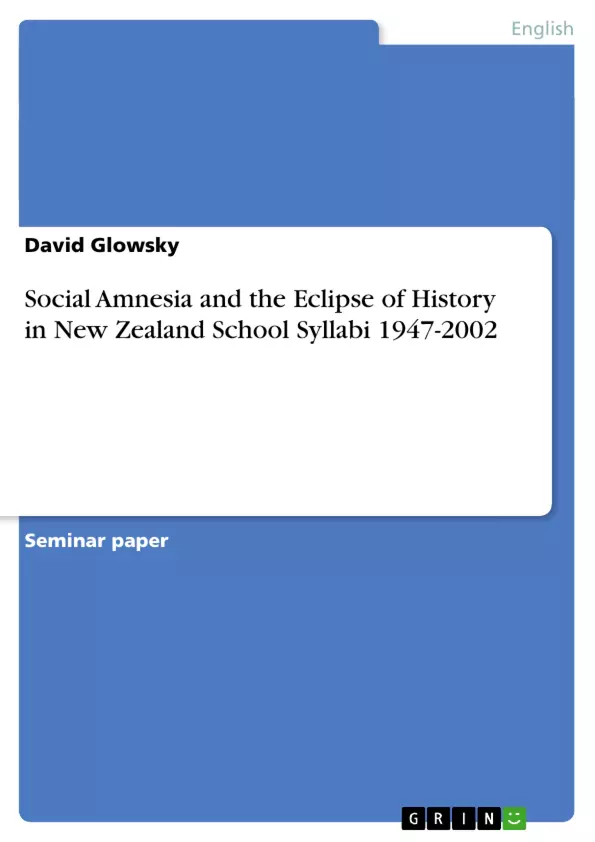This essay analyses the content of the New Zealand Social Studies and History syllabi of the past 55 years. It concentrates on the one hand on content that refers to race relations in the country, to see what information was included or excluded to draw a certain picture of race relations; on the other hand it looks at how New Zealand interprets its links to other countries, to find out where it places itself culturally and politically in the world. It looks for patterns within the curriculum content that indicate certain ideological directions at the time the curricula were written, and for changes in these patterns over time. The underlying assumption here is that ‘any school curriculum, regardless of its composition, is invariably a political instrument.’ Openshaw and Archer have shown that even Social Studies, which have been regarded as unbiased and value-free, are as indoctrinated as history syllabi of the early 20th century.
The main objective of Social Studies since its introduction in 1947 has not been to teach history. With little changes in formulation its aims have been to prepare children for life in New Zealand society, to introduce them to democratic institutions and make them eligible citizens. History as such plays a minor part in this. In 1986, Ann Low-Beer, a visiting British historian, reported that the majority of Social Studies teachers had no training in history, and historical material like primary resources hardly existed. The framework of Social Studies in the 1980s, like today, was sociological, based on general conceptions of human nature and interaction. Low-Beer’s survey of teachers in 15 Wellington Junior schools asked whether students at the end Form 4, that is at the end of the compulsory Social Studies course, had an overall view of New Zealand human history. The responses made clear that ‘“Social Studies is about the present” and a picture of New Zealand [sic] past “is not the point of the course”’. According to the teachers, after eight years of Social Studies the pupils had “no idea”, they knew “not even the basics like the names of Prime Ministers this century” and it was “best to assume total ignorance of history in all pupils entering Form V”.5 Pupils thought similar about this issue. Keen found in 1977 that only 25% of older pupils felt that Social Studies had given them any insight into history.
Inhaltsverzeichnis (Table of Contents)
- Introduction
- Social Studies
- The 1947 syllabus
- The 1961 syllabus
- The 1981 reassessment of the 1961 syllabus
- The monocultural nature of the 1961/1981 syllabus
- The 1997 syllabus
- Debate about the new curriculum
- The final version
- History
- Race relations
- Great Britain
- Relations in the South Pacific and Asia and Studies of Imperialism
Zielsetzung und Themenschwerpunkte (Objectives and Key Themes)
This essay examines the content of New Zealand Social Studies and History syllabi from 1947 to 2002, with a focus on the representation of race relations and the country's self-positioning within global cultural and political contexts. It aims to identify patterns in curriculum content that reflect prevailing ideological directions and to track changes in these patterns over time. The underlying assumption is that school curricula serve as political instruments, shaping student understanding and perceptions.
- The evolution of race relations in New Zealand as portrayed in school syllabi
- The shifting role of British history and cultural influence in the curriculum
- The impact of the 'eclipse of history' on New Zealand's understanding of its past
- The relationship between social studies and history as separate subjects
- The potential influence of curriculum content on national identity and social amnesia
Zusammenfassung der Kapitel (Chapter Summaries)
The introduction lays out the essay's objectives, focusing on the analysis of race relations and New Zealand's self-positioning within the world in Social Studies and History syllabi over a 55-year period. It also highlights the key concept of social amnesia as a potential consequence of neglecting the past in education.
The "Social Studies" section examines the evolution of the subject, beginning with the 1947 syllabus, which emphasizes a Eurocentric perspective. It traces changes in the focus on New Zealand society, the inclusion of social problems, and the increasing emphasis on global perspectives. The analysis delves into specific content from each syllabus, highlighting the changing portrayal of race relations, British influence, and the evolving approach to history.
Schlüsselwörter (Keywords)
Social amnesia, race relations, New Zealand history, British influence, education policy, curriculum analysis, national identity, social studies, history, ideological directions, global perspectives, social problems.
- Quote paper
- David Glowsky (Author), 2002, Social Amnesia and the Eclipse of History in New Zealand School Syllabi 1947-2002, Munich, GRIN Verlag, https://www.hausarbeiten.de/document/20228


